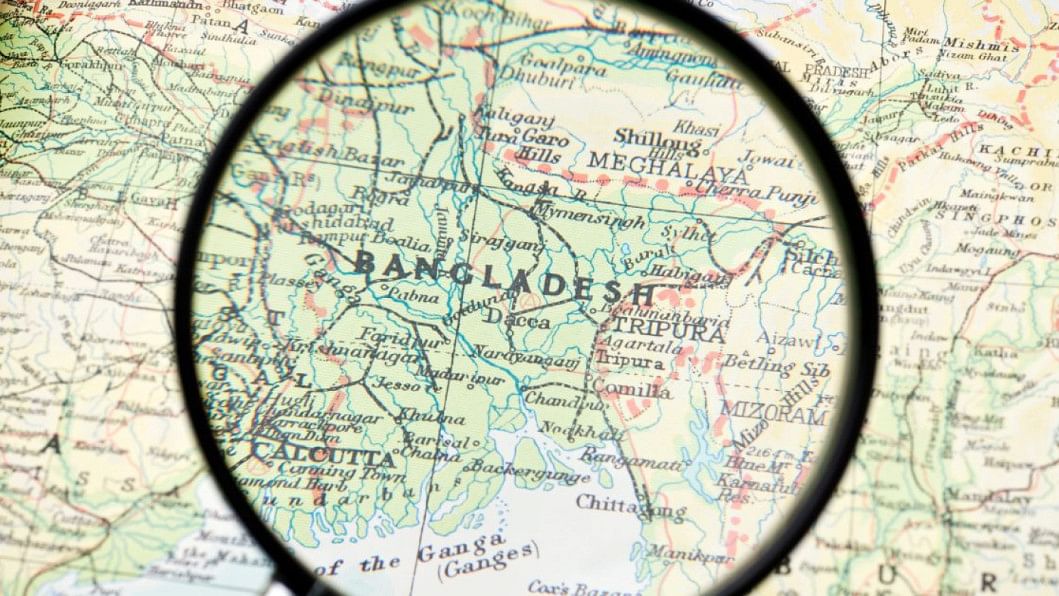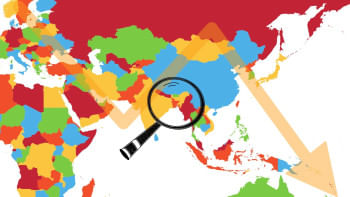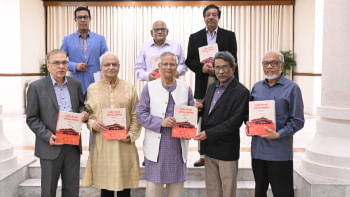Navigating the US-China-India triangular labyrinth

The advent of a new political party in Bangladesh demands a diplomatic vision rooted not in traditional alignments but in nimble strategic thinking. As global power dynamics tilt towards a volatile balance between the United States, China, and India, the party's survival and success depend on its ability to chart this complex triangle without compromising sovereignty, economic prospects, or democratic integrity. In this context, the nature of a political party's foreign policy, especially how it balances international friendships while securing domestic legitimacy, emerges as a cornerstone of governance. A right negotiation on the global stage will determine the party's resilience at home.
The National Citizen Party (NCP), being a newcomer to the political landscape, is no exception to the demands of strategic manoeuvring. It, too, must engage in the gauzy act of balancing within the triangular dynamics of the US, China, and India—an essential yet knotty task that defines political survival, foreign policy coherence, and long-term relevance in a shifting global order.
Historical geometry of foreign powers in our domestic politics
Since its inception, Bangladesh's political landscape has been influenced by the gravitational pull of external powers. The nation has endured ideological shifts, economic dependencies, and strategic coercions from India, China, and the US. While some political actors maintained longevity by bending towards one pole or another, others perished due to diplomatic miscalculations despite considerable domestic support.
India, being the first state to recognise Bangladesh's sovereignty in 1971, has maintained deep-rooted influence through security, cultural, and economic ties. China, on the other hand, has capitalised on economic diplomacy and military assistance, becoming Bangladesh's top trading partner and largest source of foreign investment. The US, often donning the cloak of democratic advocacy, exerts its power through developmental aid, political influence campaigns, and geopolitical manoeuvring—most notably its interest in strategic installations like Saint Martin's Island.
The challenge for the new political party is therefore more nuanced than before. It must not only balance three giants but do so while managing their competing pressures within Bangladesh's own political narrative. This, in effect, transforms Bangladesh's foreign policy into a diamond—multifaceted, precious, and at constant risk of shattering under pressure if not managed with precision.
Context of the new party
The emergence of this new political force is not taking place in a vacuum. It is born into a climate where propaganda, perception, and political branding have become more vital than ideology. With competing narratives, both domestic and foreign, already attempting to define the party's image, it must actively shape its own identity. This requires a disciplined diplomatic front that reflects neither overt alignment nor vague neutrality, but a deliberate strategy of "strategic equidistance."
In such a context, the party must constantly update its foreign policy toolkit. Unlike previous eras where ideology could offer direction, today's diplomacy requires a technocratic blend of pragmatism, optics, and influence management.
The call for a middle path doctrine
Bangladesh's new political leadership must move away from the binary Cold War framework of choosing allies. Instead, it must institutionalise the doctrine of "Middle Path Diplomacy." This approach seeks partnerships based on mutual benefit, national interest, and non-alignment—a more pragmatic version of the old Bangladeshi principle of "friendship to all, malice to none."
The US, China, and India each bring both opportunity and risk. Bangladesh must leverage China's economic clout without falling into debt traps. With India, it must pursue neighbourly diplomacy that respects sovereignty and mitigates asymmetry. The US remains a key partner in trade and security, but its interventions in domestic politics necessitate a cautious engagement model.
For this middle path to succeed, it must be fluid, not fixed, evolving as regional and global tensions shift. Strategic hedging, multilateralism, and soft power projection should be the tripod of this new diplomatic architecture.
India: The hardest balancing act in the tripartite game
Among the three, India poses the most complex diplomatic challenge. As both a neighbour and a hegemon-in-waiting, India's relationship with Bangladesh is deeply connected with domestic politics, water and energy security, border stability, and cultural memory.
India's support of Sheikh Hasina's Awami League and its scepticism of the BNP (seen as pro-China and Islamist-leaning) have long impacted Bangladesh's internal political equilibrium. Transit agreements, power exports, intelligence sharing, and strategic pressure points like the Teesta River dispute and Citizenship Amendment Act/National Register of Citizens controversies are instrumental tools New Delhi wields in its policy toolkit.
Thus, the new party's India strategy must extend beyond state-to-state diplomacy. It must engage India's civil society, intelligentsia, and regional actors, especially in West Bengal and Northeast India, to form a buffer against top-down pressures. National security, economic parity, and public opinion in both countries must anchor this engagement, not emotion, nostalgia, or ideological romanticism.
Revitalising regional frameworks
No foreign policy of balance is sustainable without multilateral anchors. Regional organisations such as SAARC, BIMSTEC, and ASEAN must be rejuvenated as platforms for non-hegemonic cooperation. These frameworks can act as diplomatic equalisers, giving smaller states like Bangladesh collective bargaining power in a polarised global order.
SAARC, though stymied by India-Pakistan tensions, can still be instrumental in people-to-people connectivity and climate resilience. BIMSTEC, with its focus on the Bay of Bengal, provides a strategic maritime pivot point, while ASEAN's economic corridors can help Bangladesh diversify its alliances beyond the big three.
The African Union's (AU) model is worth studying here. With its assertive stance against foreign domination, emphasis on intra-continental trade (AfCFTA), and pushback against debt-trap diplomacy, the AU exemplifies how regional coalitions can counterbalance global pressures. Bangladesh's new political party must take inspiration from such models to propose a "Bay of Bengal Compact" or a "South Asian Strategic Community" that ensures collective self-reliance.
The inconvenient truth about meddling
The entanglement of the US, India, and China in Bangladesh's domestic affairs is not speculative—it is empirical. The US has deployed soft power via USAID and programmes like IRI's "Promoting Accountability, Inclusivity, and Resiliency" initiative, funding activists, cultural projects, and civil society movements critical of the ruling party. Allegations of attempted regime change, pressure campaigns against politicians, and the leverage of military base proposals (Saint Martin's Island) further expose the depth of American interest.
India, meanwhile, has utilised both carrot and stick—offering infrastructure projects and energy cooperation on one hand, while exerting pressure through border policies, trade asymmetries, and political favouritism on the other. China, though more restrained in public diplomacy, quietly embeds itself through infrastructure megaprojects, military sales (accounting for over 70 percent of Bangladesh's arms imports), and strategic port development—all aimed at securing long-term influence.
The new political party must publicly acknowledge these realities, not as anti-Western, anti-Indian, or anti-Chinese rhetoric, but as pragmatic considerations in formulating a sovereign foreign policy.
A new political cartography for a post-fascist democracy
The geopolitical stakes are high for any new political actor in Bangladesh. The country is at the crossroads of a shifting world order, where traditional alliances are obsolete and soft power is the new currency of diplomacy. The emergence of this new political force must be guided not by ideology alone but by strategic realism, dignified neutrality, and intelligent manoeuvring.
A future-oriented foreign policy, based on equal dignity, regional solidarity, and multilateral engagement, will help Bangladesh insulate itself from undue influence while maximising economic and security dividends. If navigated well, the diamond that is Bangladesh's position in South Asia can refract power in multiple directions, not just absorb it. Ultimately, foreign policy is no longer a peripheral concern of governance. It is central to legitimacy, survival, and progress. The new political party must tread carefully, yes, but it must also tread wisely.
Alauddin Mohammad is joint member secretary of National Citizen Party (NCP) and executive director at Institute of Policy, Governance and Development (IPGAD).
Views expressed in this article are the author's own.
Follow The Daily Star Opinion on Facebook for the latest opinions, commentaries and analyses by experts and professionals. To contribute your article or letter to The Daily Star Opinion, see our guidelines for submission.


 For all latest news, follow The Daily Star's Google News channel.
For all latest news, follow The Daily Star's Google News channel. 







Comments